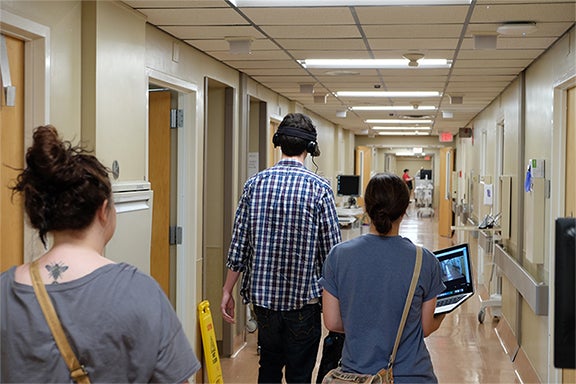Just about wherever humans may go, there are usually some kinds of indicators to help us find our way. From trail markers to area or room design, wayfinding is an art and science we may take for granted--we pick up cues and continue on our way. But how can the science of wayfinding help people who are experiencing memory loss? Family and Consumer Sciences faculty Hessam Ghamari shows the way.

This story is re-posted from CSUN Today. Read the story in CSUN Today.
Have you ever been to a new place — whether a building at school, a shopping mall or a hospital — and gotten lost or disoriented somewhere along the way?
California State University, Northridge professor of interior design Hessam Ghamari explores this very sensation by examining the impact of the environment on our health and well-being through the use of evidence-based technology. These technologies examine where we look, what we ignore and what grabs our focus when we’re at a new location.
Ghamari is on a quest to harness concepts in interior design to improve individuals’ ability to “wayfind” in unfamiliar places.
“Interior design goes beyond the aesthetics of a space,” Ghamari said. “We, as designers, [must be] responsible to think in terms of how design can improve health and well-being. Through neuroimaging and eye-tracking technology, we can better understand what visual and environmental factors people rely on to navigate a space.”
Ghamari said he hopes to ease this wayfinding process not just for students, shoppers and patients, but in particular for people battling dementia or Alzheimer’s disease, who often forget where they are and have been due to memory loss.
“When it comes to dementia patients, we’re talking about people who have cognitive decline,” Ghamari said. “They forget where they have been. They may see a landmark, but then they may not remember where that landmark is. By improving their ability to find their way, we improve their sense of freedom, which in turn improves their health.”
Through his research, Ghamari has found that health care facilities can improve the lives of dementia patients by implementing certain architectural and interior design elements.
“Since people with dementia are supervised most of the time for safety and security reasons, this results in a loss of freedom and self-esteem. Consequently, there is an increase in stress, anxiety and depression among dementia patients,” he said. “My goal is to restore their sense of freedom by designing an environment that is navigable.”
One way to improve a patient with dementia’s ability to find their way is fairly straight-forward: Provide a layout with little directional change, such as a simple, straight corridor or an L-shaped corridor, rather than a more complex layout, Ghamari explained. This streamlines pathways.
In addition, specific, distinguishing colors for residents’ doors and rooms in an assisted-care or memory-care facility can also help to enhance orientation. Similarly, unique furnishings or items that provide architectural differentiation aid in a patient with dementia’s ability to determine which room is theirs, the professor noted.
“The environment around us is influential in shaping our behavior,” Ghamari said. “Knowing how the environment around us affects our decision-making processes is crucial to knowing how to design a space.”
Ghamari also has found that placing a display case or shadow box that includes personal memorabilia outside an individual’s door can drastically improve their ability to locate their room in a facility, because seeing their personal touchstone pieces can help guide them to their living quarters. Moreover, bright, even, glare-free lighting is best, since it reduces depression and improves mood, as does adding natural light (with a skylight or windows) in the rooms of dementia patients, he said.
Ghamari encourages his students to incorporate evidence-based research, such as the environmental psychology he explores, into their studies as well. If interior designers were to use these techniques and concepts, their work could enhance and improve the well-being of their clients, he said. “Since I began working at CSUN last fall, I have been having a lot of conversations with my students — both last semester and this semester — about research-based design,” Ghamari said.
“It is important to teach students that interior design goes beyond how the environment looks,” he said. “It’s not necessarily about the beauty or aesthetics of a space. It goes beyond that — the safety, security, health, well-being and the functionality of a space are all equally crucial components to design.”
This story is re-posted from CSUN Today. Read the story in CSUN Today.
Sp 2019
Jessica Edwards/CSUN Today
